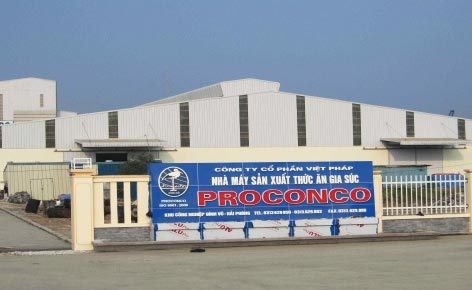Proconco inaugurates latest animal feed plant

The new facility is the company’s seventh in Vietnam and joins the existing two in Dong Nai and other plants in Haiphong, Can Tho, Hung Yen and Hanoi.
Nguyen Thi Le Hong, chairwoman of Proconco said the factory would cover five hectares and produce 150,000 tonnes of product per year. Hong added that in the second phase, the company would invest $18.7 million into doubling its capacity. According to Hong, the new facility will meet the increasing demand for animal feed in central and Central Highlands provinces.
Animal feed companies in Vietnam have faced fierce competition, but Proconco has sold 1.3 million tonnes of products thanks to its model production line.
According to the Vietnam Animal Feed Association, this year the total capacity of animal feed is set to increase 10 per cent compared to the same period last year.
The compound feed industry in Vietnam has grown at a rate of 13-15 per cent annually. Last year, the country produced about 17 million tonnes with 50 foreign-invested companies accounting for 25 per cent of the number of firms, but a gigantic 65-70 per cent market share of the country’s animal feed output. Thailand’s CP Group alone holds a 15 per cent share and Proconco 10 per cent. The total national output is expected to reach 18-20 million tonnes in 2015 and rise to 25-26 million tonnes in 2020.
Last year, Vietnam imported 9.2 million tonnes of animal feed and additives, worth $4.5 billion, up 27.46 per cent on-year. Products imported include protein-rich feed such as soybean, meat and fish powder and energy-rich products such as wheat, corn and bran.
In the first ten months of this year, Vietnam spent $2.79 billion importing animal feed and supplemental foods, up 6.3 per cent on-year, mainly from Argentina (38.4 per cent), the US (12.2 per cent) and China (9 per cent).
What the stars mean:
★ Poor ★ ★ Promising ★★★ Good ★★★★ Very good ★★★★★ Exceptional
Latest News
More News
- Strengthening supply chains through trade promotions and customs reform (December 24, 2025 | 14:00)
- PM orders investment model for North–South high-speed rail (December 22, 2025 | 17:43)
- LS Eco Energy to invest in Vietnam rare earth sector (December 22, 2025 | 17:31)
- Government moves to establish International Financial Centre (December 21, 2025 | 21:00)
- Vietnam's IFC to target global investment flows (December 21, 2025 | 18:00)
- Two national hospitals expand capacity with new facilities (December 20, 2025 | 09:00)
- Ha Tinh breaks ground on major Vingroup industrial and energy projects (December 19, 2025 | 18:24)
- EVN launches major power infrastructure projects nationwide (December 19, 2025 | 18:17)
- VAL inaugurates second production line to meet domestic animal feed demand (December 19, 2025 | 16:37)
- Sun Group pioneers urban tram system in Phu Quoc (December 19, 2025 | 15:00)


















 Mobile Version
Mobile Version